SIT103 Data and Information Management Assignment Solution - 2018
VerifiedAdded on 2023/05/29
|7
|1496
|79
Homework Assignment
AI Summary
This assignment solution addresses key concepts in data and information management, covering topics relevant to the SIT103 course. The solution begins with an overview of Database Management Systems (DBMS), including their advantages (reducing data redundancy, data sharing, data integrity, and security) and essential functions (data definition, manipulation, security, integrity, recovery, and concurrency). It then delves into big data, discussing its challenges (volume, uncertainty, and data integration) and new technologies (predictive analytics, NoSQL databases, stream analytics, and data virtualization). The solution also explains transactions, their properties (atomicity, consistency, isolation, and durability), and deadlocks. Furthermore, it covers SQL commands for data manipulation (INSERT, UPDATE, and SELECT), along with database design principles (business rules, E-R modeling, relationship modeling, and normalization). The assignment references relevant literature to support the concepts discussed.
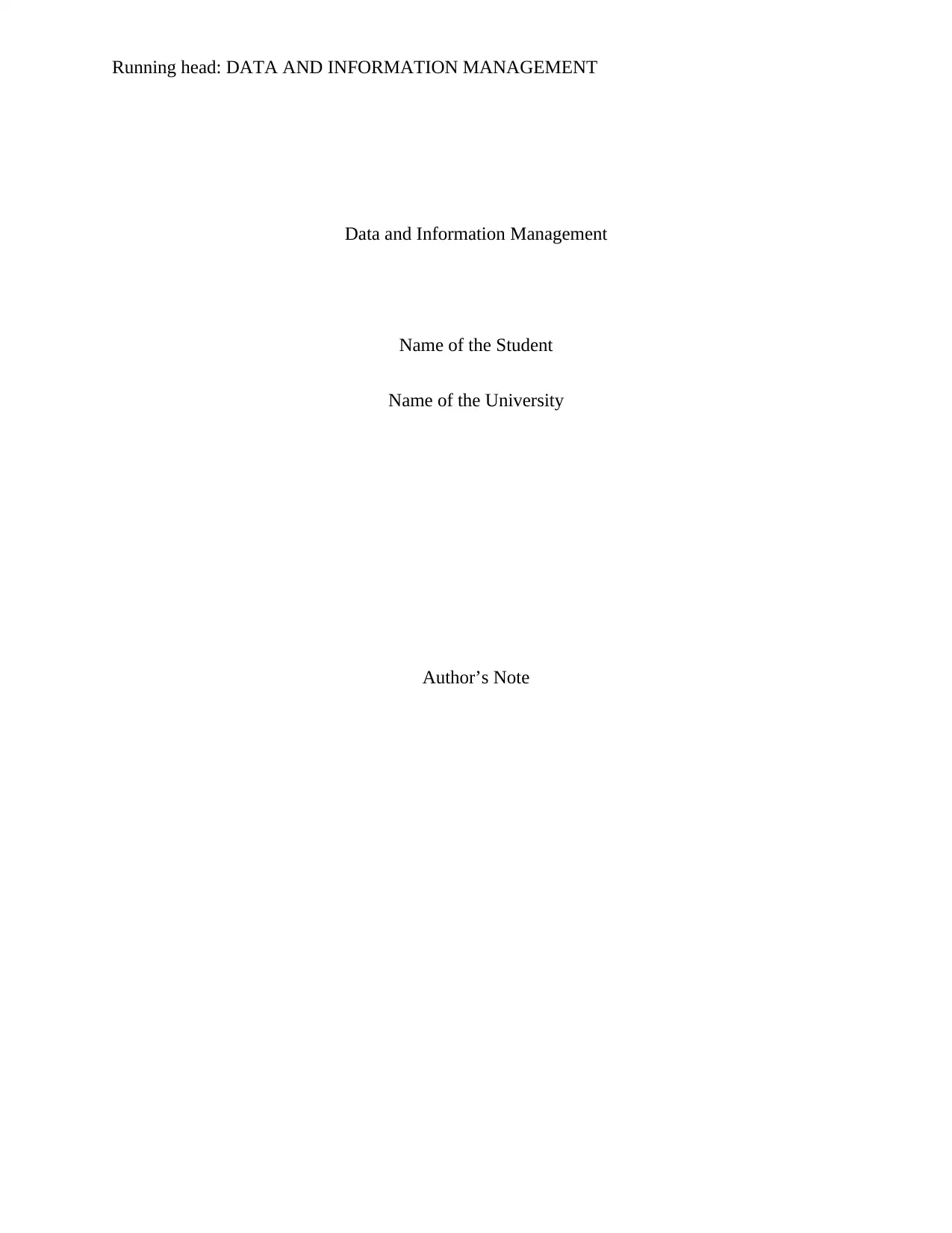
Running head: DATA AND INFORMATION MANAGEMENT
Data and Information Management
Name of the Student
Name of the University
Author’s Note
Data and Information Management
Name of the Student
Name of the University
Author’s Note
Paraphrase This Document
Need a fresh take? Get an instant paraphrase of this document with our AI Paraphraser
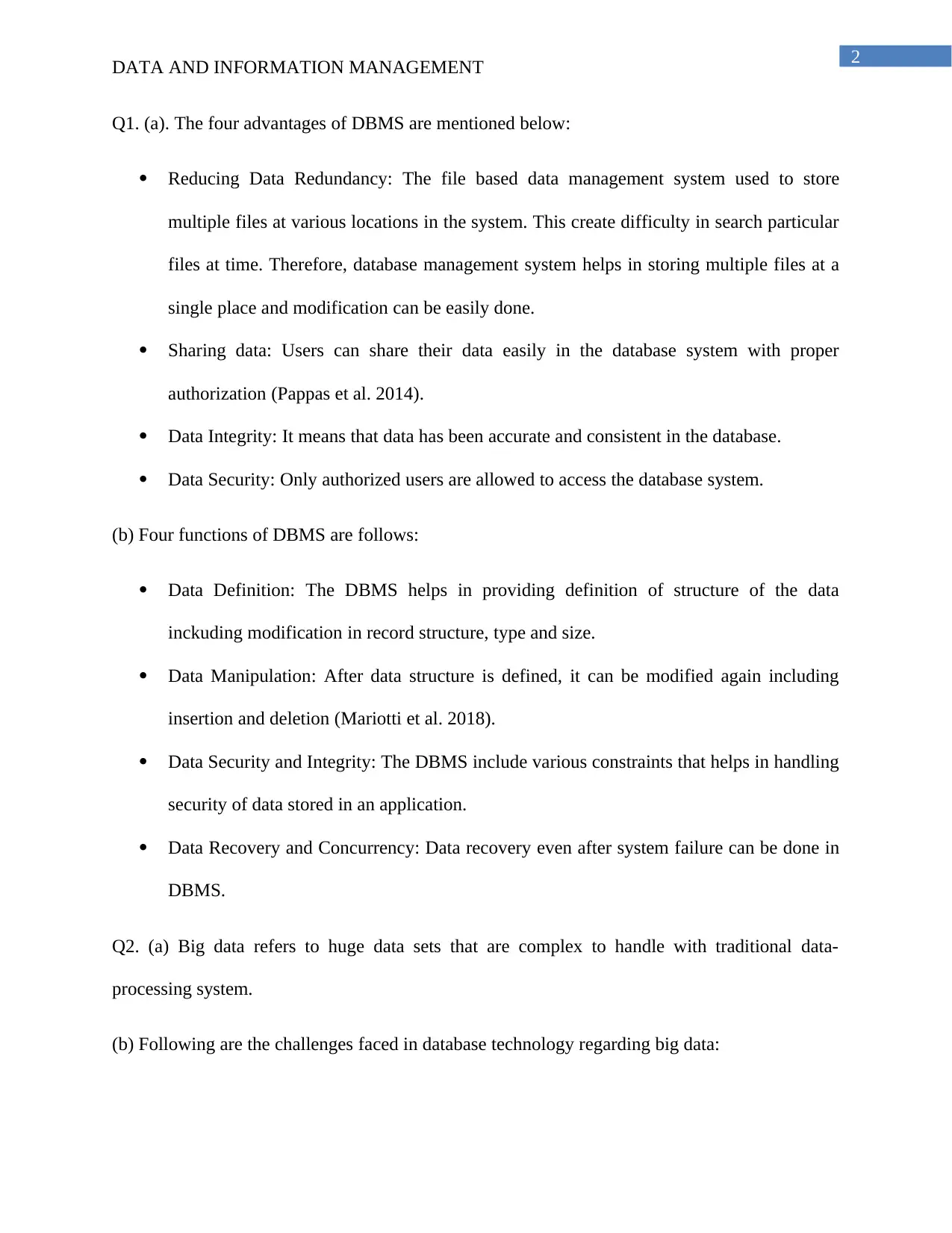
2
DATA AND INFORMATION MANAGEMENT
Q1. (a). The four advantages of DBMS are mentioned below:
Reducing Data Redundancy: The file based data management system used to store
multiple files at various locations in the system. This create difficulty in search particular
files at time. Therefore, database management system helps in storing multiple files at a
single place and modification can be easily done.
Sharing data: Users can share their data easily in the database system with proper
authorization (Pappas et al. 2014).
Data Integrity: It means that data has been accurate and consistent in the database.
Data Security: Only authorized users are allowed to access the database system.
(b) Four functions of DBMS are follows:
Data Definition: The DBMS helps in providing definition of structure of the data
inckuding modification in record structure, type and size.
Data Manipulation: After data structure is defined, it can be modified again including
insertion and deletion (Mariotti et al. 2018).
Data Security and Integrity: The DBMS include various constraints that helps in handling
security of data stored in an application.
Data Recovery and Concurrency: Data recovery even after system failure can be done in
DBMS.
Q2. (a) Big data refers to huge data sets that are complex to handle with traditional data-
processing system.
(b) Following are the challenges faced in database technology regarding big data:
DATA AND INFORMATION MANAGEMENT
Q1. (a). The four advantages of DBMS are mentioned below:
Reducing Data Redundancy: The file based data management system used to store
multiple files at various locations in the system. This create difficulty in search particular
files at time. Therefore, database management system helps in storing multiple files at a
single place and modification can be easily done.
Sharing data: Users can share their data easily in the database system with proper
authorization (Pappas et al. 2014).
Data Integrity: It means that data has been accurate and consistent in the database.
Data Security: Only authorized users are allowed to access the database system.
(b) Four functions of DBMS are follows:
Data Definition: The DBMS helps in providing definition of structure of the data
inckuding modification in record structure, type and size.
Data Manipulation: After data structure is defined, it can be modified again including
insertion and deletion (Mariotti et al. 2018).
Data Security and Integrity: The DBMS include various constraints that helps in handling
security of data stored in an application.
Data Recovery and Concurrency: Data recovery even after system failure can be done in
DBMS.
Q2. (a) Big data refers to huge data sets that are complex to handle with traditional data-
processing system.
(b) Following are the challenges faced in database technology regarding big data:
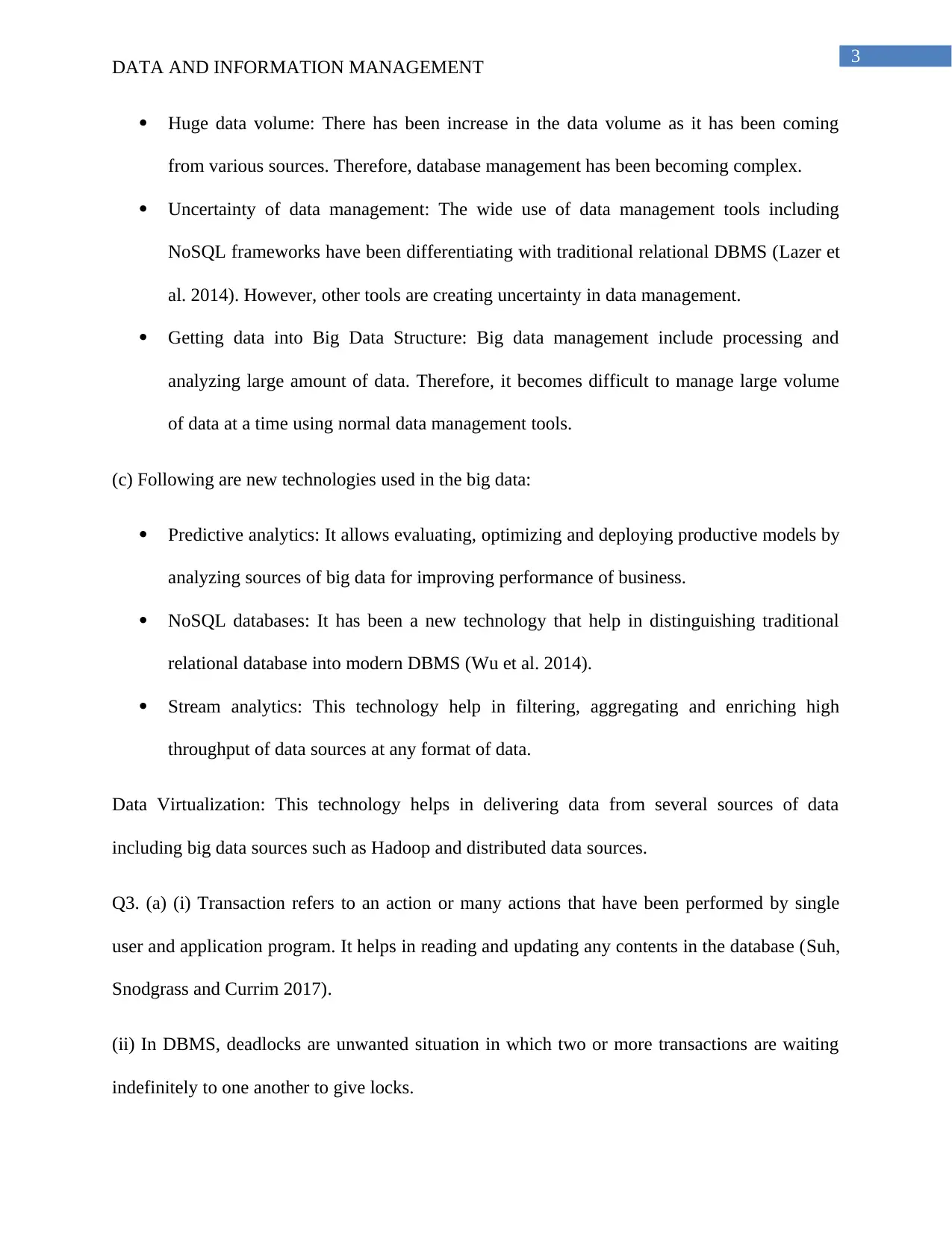
3
DATA AND INFORMATION MANAGEMENT
Huge data volume: There has been increase in the data volume as it has been coming
from various sources. Therefore, database management has been becoming complex.
Uncertainty of data management: The wide use of data management tools including
NoSQL frameworks have been differentiating with traditional relational DBMS (Lazer et
al. 2014). However, other tools are creating uncertainty in data management.
Getting data into Big Data Structure: Big data management include processing and
analyzing large amount of data. Therefore, it becomes difficult to manage large volume
of data at a time using normal data management tools.
(c) Following are new technologies used in the big data:
Predictive analytics: It allows evaluating, optimizing and deploying productive models by
analyzing sources of big data for improving performance of business.
NoSQL databases: It has been a new technology that help in distinguishing traditional
relational database into modern DBMS (Wu et al. 2014).
Stream analytics: This technology help in filtering, aggregating and enriching high
throughput of data sources at any format of data.
Data Virtualization: This technology helps in delivering data from several sources of data
including big data sources such as Hadoop and distributed data sources.
Q3. (a) (i) Transaction refers to an action or many actions that have been performed by single
user and application program. It helps in reading and updating any contents in the database (Suh,
Snodgrass and Currim 2017).
(ii) In DBMS, deadlocks are unwanted situation in which two or more transactions are waiting
indefinitely to one another to give locks.
DATA AND INFORMATION MANAGEMENT
Huge data volume: There has been increase in the data volume as it has been coming
from various sources. Therefore, database management has been becoming complex.
Uncertainty of data management: The wide use of data management tools including
NoSQL frameworks have been differentiating with traditional relational DBMS (Lazer et
al. 2014). However, other tools are creating uncertainty in data management.
Getting data into Big Data Structure: Big data management include processing and
analyzing large amount of data. Therefore, it becomes difficult to manage large volume
of data at a time using normal data management tools.
(c) Following are new technologies used in the big data:
Predictive analytics: It allows evaluating, optimizing and deploying productive models by
analyzing sources of big data for improving performance of business.
NoSQL databases: It has been a new technology that help in distinguishing traditional
relational database into modern DBMS (Wu et al. 2014).
Stream analytics: This technology help in filtering, aggregating and enriching high
throughput of data sources at any format of data.
Data Virtualization: This technology helps in delivering data from several sources of data
including big data sources such as Hadoop and distributed data sources.
Q3. (a) (i) Transaction refers to an action or many actions that have been performed by single
user and application program. It helps in reading and updating any contents in the database (Suh,
Snodgrass and Currim 2017).
(ii) In DBMS, deadlocks are unwanted situation in which two or more transactions are waiting
indefinitely to one another to give locks.
⊘ This is a preview!⊘
Do you want full access?
Subscribe today to unlock all pages.

Trusted by 1+ million students worldwide
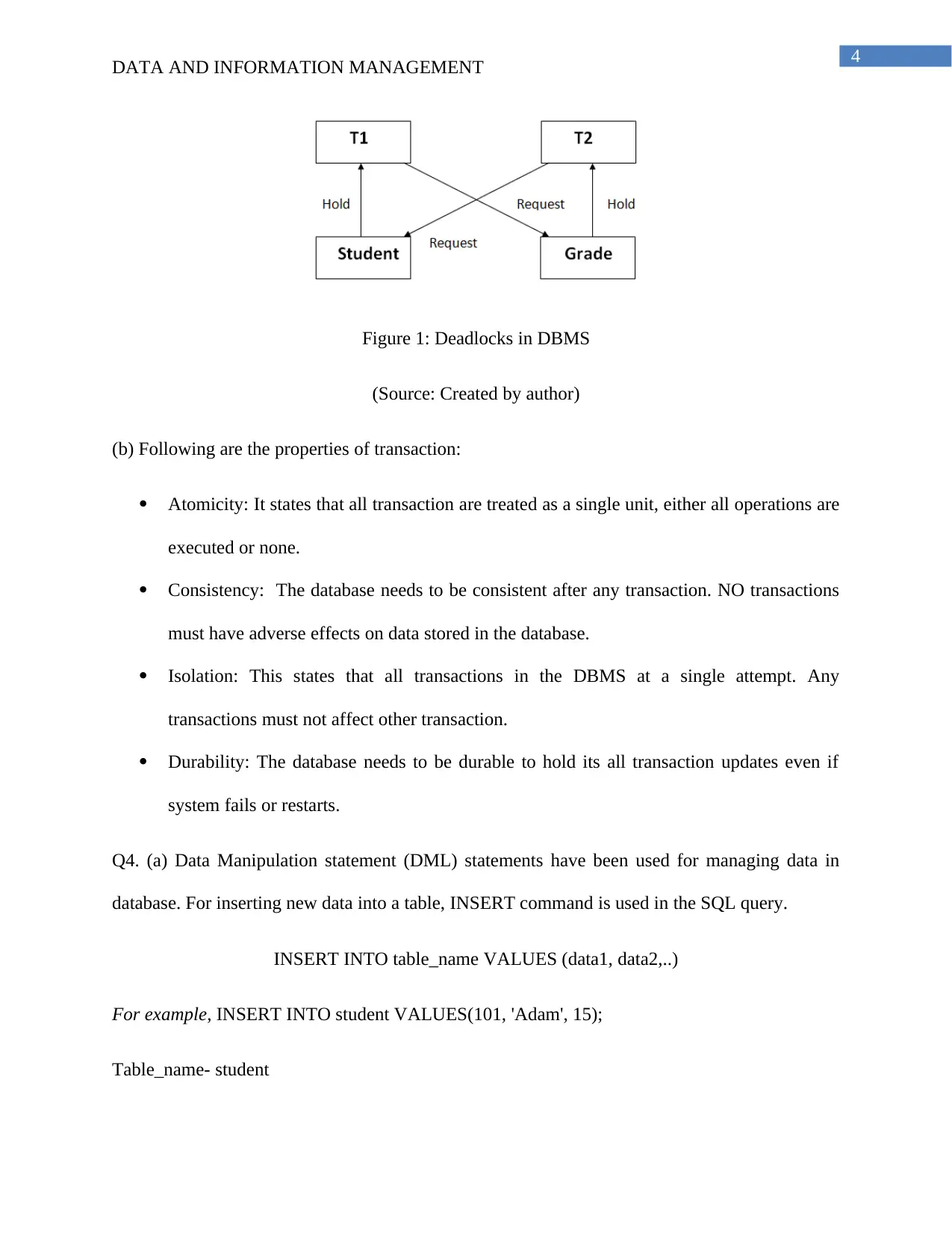
4
DATA AND INFORMATION MANAGEMENT
Figure 1: Deadlocks in DBMS
(Source: Created by author)
(b) Following are the properties of transaction:
Atomicity: It states that all transaction are treated as a single unit, either all operations are
executed or none.
Consistency: The database needs to be consistent after any transaction. NO transactions
must have adverse effects on data stored in the database.
Isolation: This states that all transactions in the DBMS at a single attempt. Any
transactions must not affect other transaction.
Durability: The database needs to be durable to hold its all transaction updates even if
system fails or restarts.
Q4. (a) Data Manipulation statement (DML) statements have been used for managing data in
database. For inserting new data into a table, INSERT command is used in the SQL query.
INSERT INTO table_name VALUES (data1, data2,..)
For example, INSERT INTO student VALUES(101, 'Adam', 15);
Table_name- student
DATA AND INFORMATION MANAGEMENT
Figure 1: Deadlocks in DBMS
(Source: Created by author)
(b) Following are the properties of transaction:
Atomicity: It states that all transaction are treated as a single unit, either all operations are
executed or none.
Consistency: The database needs to be consistent after any transaction. NO transactions
must have adverse effects on data stored in the database.
Isolation: This states that all transactions in the DBMS at a single attempt. Any
transactions must not affect other transaction.
Durability: The database needs to be durable to hold its all transaction updates even if
system fails or restarts.
Q4. (a) Data Manipulation statement (DML) statements have been used for managing data in
database. For inserting new data into a table, INSERT command is used in the SQL query.
INSERT INTO table_name VALUES (data1, data2,..)
For example, INSERT INTO student VALUES(101, 'Adam', 15);
Table_name- student
Paraphrase This Document
Need a fresh take? Get an instant paraphrase of this document with our AI Paraphraser
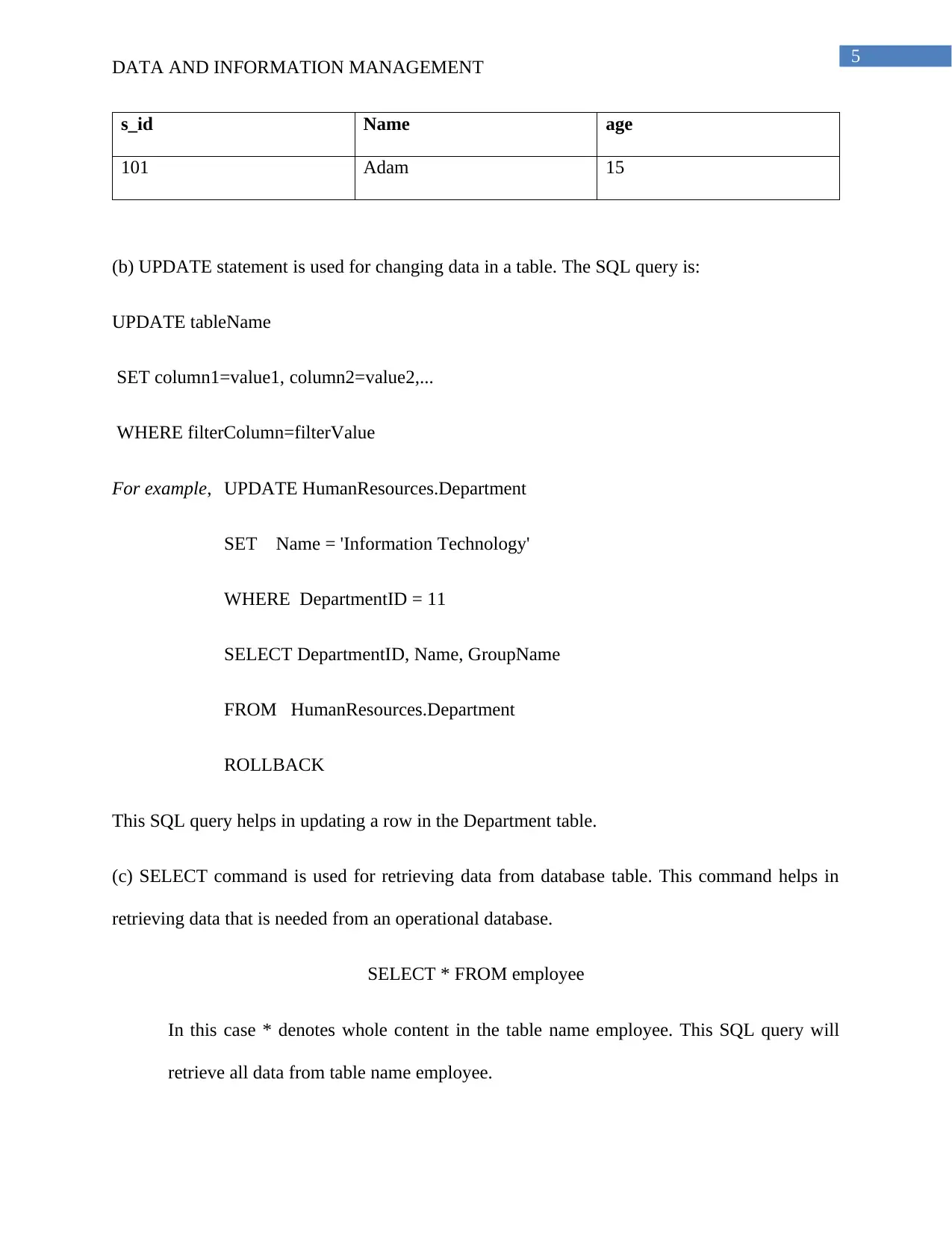
5
DATA AND INFORMATION MANAGEMENT
s_id Name age
101 Adam 15
(b) UPDATE statement is used for changing data in a table. The SQL query is:
UPDATE tableName
SET column1=value1, column2=value2,...
WHERE filterColumn=filterValue
For example, UPDATE HumanResources.Department
SET Name = 'Information Technology'
WHERE DepartmentID = 11
SELECT DepartmentID, Name, GroupName
FROM HumanResources.Department
ROLLBACK
This SQL query helps in updating a row in the Department table.
(c) SELECT command is used for retrieving data from database table. This command helps in
retrieving data that is needed from an operational database.
SELECT * FROM employee
In this case * denotes whole content in the table name employee. This SQL query will
retrieve all data from table name employee.
DATA AND INFORMATION MANAGEMENT
s_id Name age
101 Adam 15
(b) UPDATE statement is used for changing data in a table. The SQL query is:
UPDATE tableName
SET column1=value1, column2=value2,...
WHERE filterColumn=filterValue
For example, UPDATE HumanResources.Department
SET Name = 'Information Technology'
WHERE DepartmentID = 11
SELECT DepartmentID, Name, GroupName
FROM HumanResources.Department
ROLLBACK
This SQL query helps in updating a row in the Department table.
(c) SELECT command is used for retrieving data from database table. This command helps in
retrieving data that is needed from an operational database.
SELECT * FROM employee
In this case * denotes whole content in the table name employee. This SQL query will
retrieve all data from table name employee.
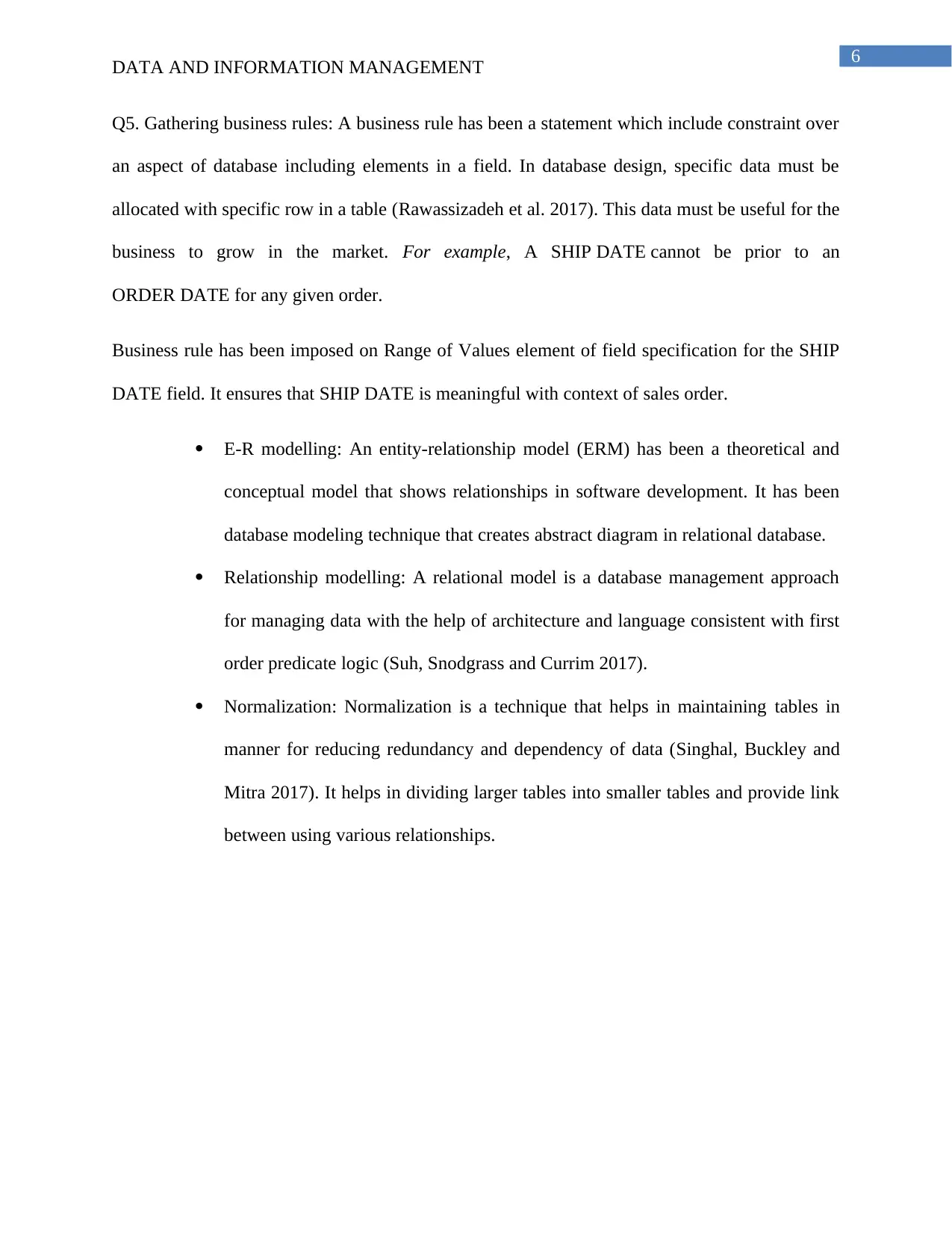
6
DATA AND INFORMATION MANAGEMENT
Q5. Gathering business rules: A business rule has been a statement which include constraint over
an aspect of database including elements in a field. In database design, specific data must be
allocated with specific row in a table (Rawassizadeh et al. 2017). This data must be useful for the
business to grow in the market. For example, A SHIP DATE cannot be prior to an
ORDER DATE for any given order.
Business rule has been imposed on Range of Values element of field specification for the SHIP
DATE field. It ensures that SHIP DATE is meaningful with context of sales order.
E-R modelling: An entity-relationship model (ERM) has been a theoretical and
conceptual model that shows relationships in software development. It has been
database modeling technique that creates abstract diagram in relational database.
Relationship modelling: A relational model is a database management approach
for managing data with the help of architecture and language consistent with first
order predicate logic (Suh, Snodgrass and Currim 2017).
Normalization: Normalization is a technique that helps in maintaining tables in
manner for reducing redundancy and dependency of data (Singhal, Buckley and
Mitra 2017). It helps in dividing larger tables into smaller tables and provide link
between using various relationships.
DATA AND INFORMATION MANAGEMENT
Q5. Gathering business rules: A business rule has been a statement which include constraint over
an aspect of database including elements in a field. In database design, specific data must be
allocated with specific row in a table (Rawassizadeh et al. 2017). This data must be useful for the
business to grow in the market. For example, A SHIP DATE cannot be prior to an
ORDER DATE for any given order.
Business rule has been imposed on Range of Values element of field specification for the SHIP
DATE field. It ensures that SHIP DATE is meaningful with context of sales order.
E-R modelling: An entity-relationship model (ERM) has been a theoretical and
conceptual model that shows relationships in software development. It has been
database modeling technique that creates abstract diagram in relational database.
Relationship modelling: A relational model is a database management approach
for managing data with the help of architecture and language consistent with first
order predicate logic (Suh, Snodgrass and Currim 2017).
Normalization: Normalization is a technique that helps in maintaining tables in
manner for reducing redundancy and dependency of data (Singhal, Buckley and
Mitra 2017). It helps in dividing larger tables into smaller tables and provide link
between using various relationships.
⊘ This is a preview!⊘
Do you want full access?
Subscribe today to unlock all pages.

Trusted by 1+ million students worldwide
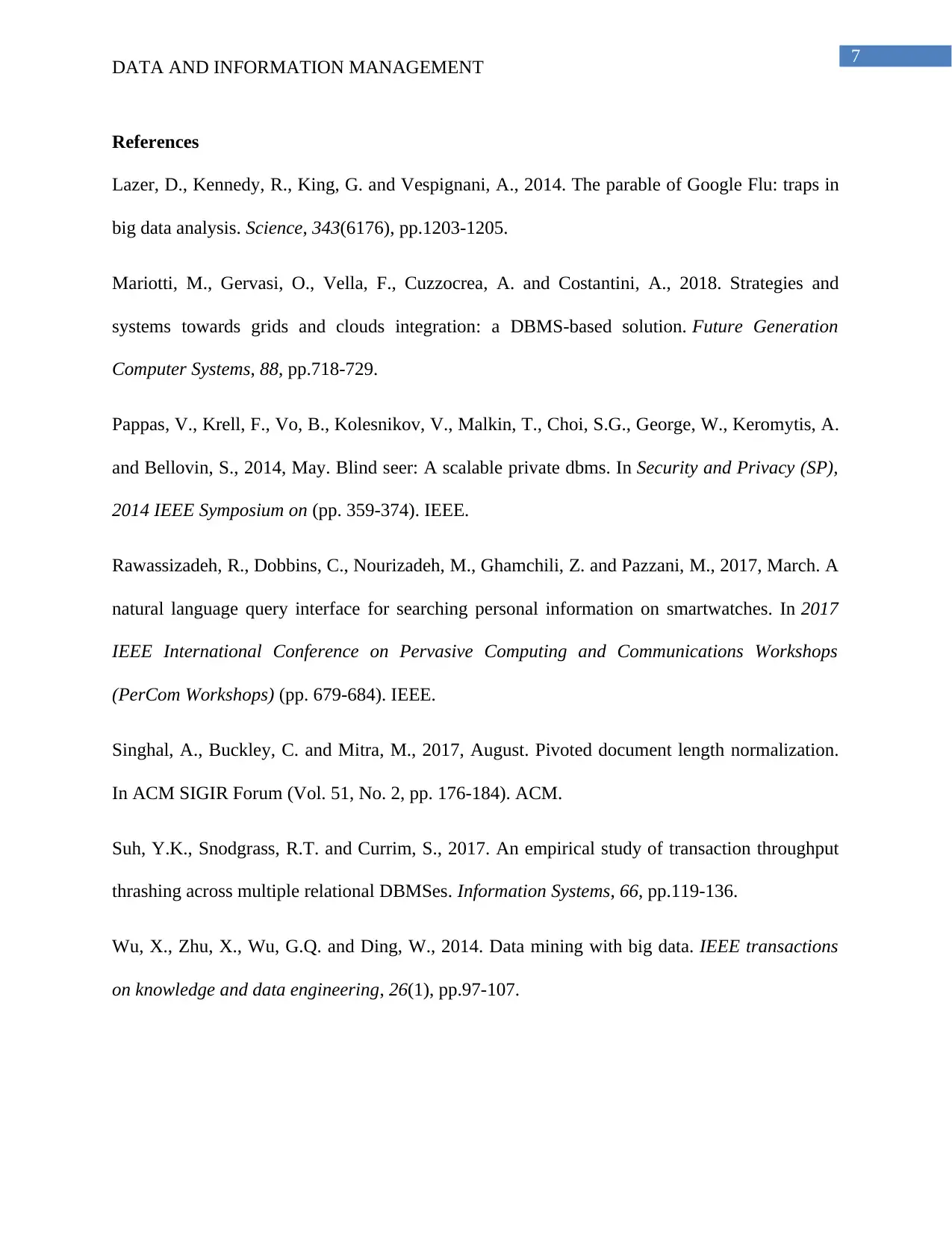
7
DATA AND INFORMATION MANAGEMENT
References
Lazer, D., Kennedy, R., King, G. and Vespignani, A., 2014. The parable of Google Flu: traps in
big data analysis. Science, 343(6176), pp.1203-1205.
Mariotti, M., Gervasi, O., Vella, F., Cuzzocrea, A. and Costantini, A., 2018. Strategies and
systems towards grids and clouds integration: a DBMS-based solution. Future Generation
Computer Systems, 88, pp.718-729.
Pappas, V., Krell, F., Vo, B., Kolesnikov, V., Malkin, T., Choi, S.G., George, W., Keromytis, A.
and Bellovin, S., 2014, May. Blind seer: A scalable private dbms. In Security and Privacy (SP),
2014 IEEE Symposium on (pp. 359-374). IEEE.
Rawassizadeh, R., Dobbins, C., Nourizadeh, M., Ghamchili, Z. and Pazzani, M., 2017, March. A
natural language query interface for searching personal information on smartwatches. In 2017
IEEE International Conference on Pervasive Computing and Communications Workshops
(PerCom Workshops) (pp. 679-684). IEEE.
Singhal, A., Buckley, C. and Mitra, M., 2017, August. Pivoted document length normalization.
In ACM SIGIR Forum (Vol. 51, No. 2, pp. 176-184). ACM.
Suh, Y.K., Snodgrass, R.T. and Currim, S., 2017. An empirical study of transaction throughput
thrashing across multiple relational DBMSes. Information Systems, 66, pp.119-136.
Wu, X., Zhu, X., Wu, G.Q. and Ding, W., 2014. Data mining with big data. IEEE transactions
on knowledge and data engineering, 26(1), pp.97-107.
DATA AND INFORMATION MANAGEMENT
References
Lazer, D., Kennedy, R., King, G. and Vespignani, A., 2014. The parable of Google Flu: traps in
big data analysis. Science, 343(6176), pp.1203-1205.
Mariotti, M., Gervasi, O., Vella, F., Cuzzocrea, A. and Costantini, A., 2018. Strategies and
systems towards grids and clouds integration: a DBMS-based solution. Future Generation
Computer Systems, 88, pp.718-729.
Pappas, V., Krell, F., Vo, B., Kolesnikov, V., Malkin, T., Choi, S.G., George, W., Keromytis, A.
and Bellovin, S., 2014, May. Blind seer: A scalable private dbms. In Security and Privacy (SP),
2014 IEEE Symposium on (pp. 359-374). IEEE.
Rawassizadeh, R., Dobbins, C., Nourizadeh, M., Ghamchili, Z. and Pazzani, M., 2017, March. A
natural language query interface for searching personal information on smartwatches. In 2017
IEEE International Conference on Pervasive Computing and Communications Workshops
(PerCom Workshops) (pp. 679-684). IEEE.
Singhal, A., Buckley, C. and Mitra, M., 2017, August. Pivoted document length normalization.
In ACM SIGIR Forum (Vol. 51, No. 2, pp. 176-184). ACM.
Suh, Y.K., Snodgrass, R.T. and Currim, S., 2017. An empirical study of transaction throughput
thrashing across multiple relational DBMSes. Information Systems, 66, pp.119-136.
Wu, X., Zhu, X., Wu, G.Q. and Ding, W., 2014. Data mining with big data. IEEE transactions
on knowledge and data engineering, 26(1), pp.97-107.
1 out of 7
Related Documents
Your All-in-One AI-Powered Toolkit for Academic Success.
+13062052269
info@desklib.com
Available 24*7 on WhatsApp / Email
![[object Object]](/_next/static/media/star-bottom.7253800d.svg)
Unlock your academic potential
Copyright © 2020–2025 A2Z Services. All Rights Reserved. Developed and managed by ZUCOL.




